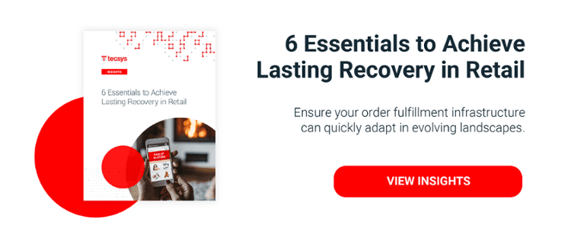
Please enjoy this republication of a RETHINK Retail article.
Throughout history, two things have proven to drive change—the economy and technology. At the confluence of these change agents lie our most dramatic shifts in society: The Industrial Revolution and shift from agrarian to industrial society; transcontinental transportation and the shift to a globalized economy; post-WWII Golden Age of Capitalism, the Baby Boom and massive expansion of suburbia. These are the inflection points in history that mark the beginning of a new way to use novel technologies and engage in commerce.
We are in the bend of yet another turning point in history. Like a bull in a china shop, the COVID-19 pandemic continues to slam through the global economy, leaving a path of destruction we cannot yet calculate. But from destruction comes creation. The collapse of old paradigms leaves open an opportunity to thrive for some sectors—and the massive gains up for grabs favor the ready.
We don’t need to travel too far back in time to see how savvy business leaders can emerge from this downturn with a clear vision and a new path to success. As the SARS pandemic arrested conventional retail models in China, Alibaba was ready. And the retail industry changed forever.
Alibaba during SARS
Jack Ma brought a China-based B2B e-commerce site to market early in 1999. The marketplace was based on similar sites that featured American companies and was designed to bring the benefits of online trade to China. Just six months after launch, Ma and his small team raised $25M, and it was ‘game time’ for Alibaba. What followed was three years of steady development and growth until the SARS pandemic struck in the fall of 2002. China’s economy, including Alibaba, was hit hard.
When the SARS outbreak began, Alibaba was at a critical phase. The team was running a B2B platform with solid results. Those results were supporting the development of Taobao, the platform that was to bring Alibaba to consumers. Enter SARS, and factories were forced to close, slowing Alibaba’s B2B business. Taobao’s launch had been set for May 2003, and delaying it was not much of an option because of eBay’s 2002 entry into the same market through acquisition. The team lumbered forward, maintaining the B2B platform and working on Taobao… until one Alibaba employee contracted SARS and the company was forced to send all its workers home.
Understanding the importance of timing, not just to fend off eBay, but to meet consumer demand for an alternative to retail, Ma enabled his employees to work from home. By keeping a core development team running point and facilitating remote work for others, Ma ensured the B2B business was supported and the Taobao release was right on time.
It is easy to see how things could have shaken out differently, and it is not hard to imagine that the SARS outbreak could have toppled Alibaba. A shrewdly laid plan to leverage a B2B platform and open a consumer e-commerce hub had been disrupted by an unprecedented pandemic. In what was a fight or flight decision, Jack Ma fought for his vision of the future of retail and recalibrated his plan to accommodate the shift in economic conditions. The rest is history. Today, Alibaba is, by many measures, the largest e-commerce site in the world.
Why SARS was both an obstacle and an opportunity
The SARS pandemic in China didn’t just close factories — it shook retail. Supply chains were disrupted; retailers faced a dearth of activity as shoppers were quarantined; consumers faced roadblocks to acquiring necessities.
All of these crippling consequences of SARS were, ultimately, a boon to Alibaba as it gave consumers a reason to use Taobao that would not have otherwise existed. The company’s massive growth cannot be attributed exclusively to SARS; Alibaba strategically offered new users fee-free sales for three years and leveraged the stability and success of the B2B platform. However, SARS served as an accelerant to the digitalization of the Chinese economy and proved to be a main driver in Taobao’s success. Had Ma been less decisive, or taken his foot off the pedal during the pandemic, the outcomes would likely not have been as good or as fast.
Omnichannel in the time of COVID-19
COVID-19 is pushing e-commerce activity to Black Friday levels. At supply chain software provider Tecsys, daily order processing activity is sustained among retailers at double the most recent Black Friday peak volumes. Consumers, barred from conventional shopping by quarantines, are flocking to the digital marketplace as retailers scramble to accommodate. Yet, the standard-bearers for e-commerce are bottlenecked and backlogged and consumer demands are not being fully met. Even Alibaba’s current CEO anticipates a decrease in e-commerce revenue during this market disruption due to a slowdown in supply chain and delivery times for Alibaba’s online business.
Just like it was nearly two decades ago, is the time ripe for smart companies to take a leap forward?
Let’s read the tea leaves. During this period of quarantine and physical distancing protocols, only a handful of storefronts are open. Of those, customer reluctance is limiting traffic. There is no doubt that we are seeing a pandemic-driven shift to digital. As reported by Forbes:
- U.S. retailers’ online year-over-year (YoY) revenue growth is up 68% as of mid-April, surpassing an earlier peak of 49% in early January.
- There’s been a 129% year-over-year growth in U.S. & Canadian e-commerce orders as of April 21 and an impressive 146% growth in all online retail orders.
- Online conversion rates increased 8.8% in February, reflecting a level of shopping urgency typically seen during Cyber Mondays, according to QuantumMetric.
Even as restrictions are lifted, the old ways of shopping are not likely to roll back entirely. Anxieties around browsing in close quarters will outlast the current restrictions in place. Meanwhile, late tech adopters have been propelled into the conveniences of multi-channel shopping. The retail renaissance is reaching primetime.
Consumer buying habits don’t change overnight with a one-off transaction. The length of closures and recurrence of quarantine orders will shape how substantially the retail landscape will transform. Many traditional brick-and-mortar retailers may never regain the market share they once enjoyed. Some will shutter, forever changing the competitive field.
However, as savvy retailers are experiencing, this does not mean that brick and mortar has become obsolete. This critical physical footprint has become a nucleus for curbside pickup, ship-from-store fulfillment and click-and-collect. And while these digitally facilitated alternatives are critical to survival in the short term, we might anticipate consumer demand forcing a permanent extension to online options even when COVID-19 is firmly in the rearview mirror.
This presents an opportunity for retail organizations that can quickly transition to non in-store shopping options, and who have the supply chain and personnel to support the shift.
Omnichannel in a post-pandemic environment
COVID-19 has established a new reality where nearly every aspect of life has shifted from analog to digital. It has changed the dynamic by twisting the paradigms of our social lives and commercial behaviors alike. E-commerce is accelerating in this new reality and is proving to be the lifeline for otherwise shuttered businesses.
This is a moment of reckoning for organizations historically dependent on foot traffic because races are won in the curves, and we’re looking at a hairpin turn. A sharp eye will see the convergence of omnichannel trends in this digital acceleration and will take advantage of technologies that can accommodate a new online retail experience.
Forward-thinking organizations will double down and anticipate the need to flex and scale to evolve with a marketplace in flux.
The very best will understand the intricacies and demands of omnichannel and the unique requirements of online consumers who, in the years since SARS, have become uncompromising in their expectation of a unified buying journey.



